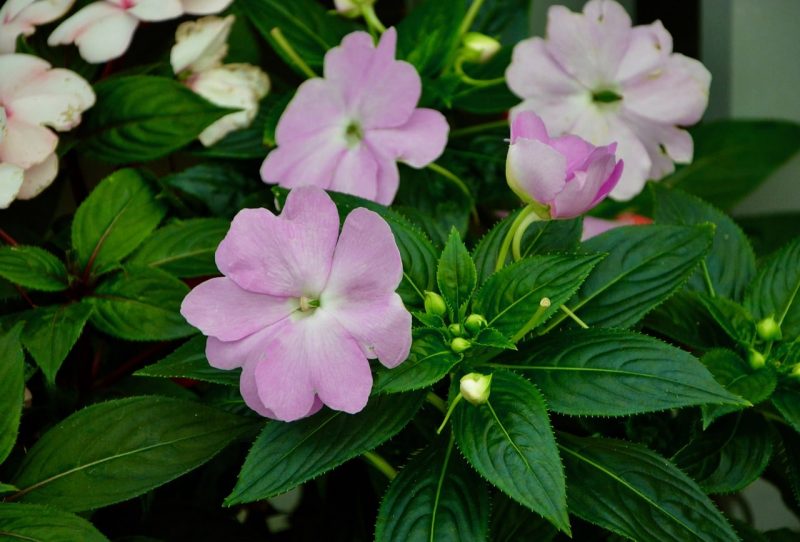Learning how to grow impatiens from cuttings is as easy as two steps. You can create more of this beautiful bedding plant using three propagation techniques, but there’s no doubt that using cuttings is the easiest. More so, starting impatiens from cuttings allows you to retain the characteristics of your chosen parent plant.
Impatiens are also one of the easiest annuals to grow, and as you will read later on, they quickly develop roots both in water and soil. However, you can skip potential problems beforehand by choosing the cultivar or variety to thrive well in your location. You can also start impatiens in the greenhouse to guarantee establishment from the stable conditions indoors.

How To Grow Impatiens From Cuttings: Beginner’s Guide
Step #1. Collecting
The first step in growing impatiens from cuttings is collecting the sections. You can do this in the fall and then raise the impatiens in the greenhouse during winter. This is the standard timing for gardeners because you can plant the established plants by the following spring.
Much like when taking cuttings from other plants, you want to make sure that your source and the sections you’ll get are healthy. The parent plant must have no sign of diseases and damages, and you can prepare it by watering the day before taking the cutting. Then, cut a 4-inch section on the growing tip or non-flowering stem below a node, ensuring that the cutting has at least two leaf nodes.
Before rooting the sections, you also want to make sure that the bottom two inches of the section have no foliage. The only leaves left should be the ones on the top, and two to four are enough. While impatiens root easily, you can also dip the end of the cutting in rooting hormone powder to hasten the root growth.
Step #2. Rooting
The beauty of propagating impatiens from cuttings is they develop relatively quickly both in water and soil. However, you may find them rooting successfully in a controlled environment like the greenhouse because they won’t get exposed to unstable temperature, humidity, light, and other external factors.
Rooting impatiens in water
Perhaps the easiest way to root impatiens is by placing the cutting in a glass with water enough to reach the nodes. You’ll just place the cutting inside while ensuring that the top leaves are not touching the water. This is important because you don’t want to encourage leaf rot.
Afterward, place the glass somewhere bright and warm but out of direct sunlight that can damage the cutting and roots. Because you’re using water, you run the risk of sunlight heating the water. As for maintenance, you must also replace the water when it changes color or refill the glass if the level has changed.
Impatiens cuttings should develop roots in water after some weeks, and you can replant them in soil once the roots are around two inches long.
Rooting impatiens in soil
Another relatively easy way to root impatiens is by placing them in soil. You can use pots or planting trays filled with potting soil or your mix. Make sure the medium is damp, and this should encourage rooting successfully.
Poke a hole in the middle of the medium and then insert the cutting in it. After the placement, you want to water it once again and place somewhere warm, bright, but out of direct light. If you want, and if your climate is not harsh, you can also set the cuttings directly in the garden as long as the location provides some shade.
The development of roots can take weeks to a month, and you can transplant the cuttings once they have developed true leaves. However, the emphasis is necessary on hardening them first to avoid transplant shock. More so, check your calendar if it is safe to transplant the cuttings; otherwise, maintain them in the greenhouse.
How To Maintain Impatiens
Impatiens already give you a headstart by not having too many requirements to maintain their overall health. However, it’s still important to remember their ideal conditions to avoid drawbacks. For example, you must water your plants and conserve soil moisture consistently.
You can mulch your soil and add in some organic matter, in addition to daily checking, especially during the dry season. If you are growing impatiens in the greenhouse, you can also feed the container plants with a liquid fertilizer to keep them healthy. Otherwise, a slow-release fertilizer when you plant them should provide their needed nutrients.
Lastly, some gardeners pinch their impatiens as part of maintenance. This should encourage better growth, especially for older plants. However, the good news is that you won’t need to deadhead impatiens because it is self-cleaning.
Conclusion
Impatiens are one of the easiest bedding plants to grow and propagate. But if you have existing plants, you must learn how to grow impatiens from cuttings for a quick and reliable way to get more copies of your favorites. The fantastic thing with impatiens is that you can grow them from cuttings in fall, place them in the greenhouse, and transplant for the following spring.
There are no special techniques, and the method is as simple as taking the cutting, removing the bottom leaves, and choosing where you want to root them. You can use a glass of water or plant them in pots or the garden. Impatiens should develop roots within weeks, and you can transplant once they grew true leaves.
